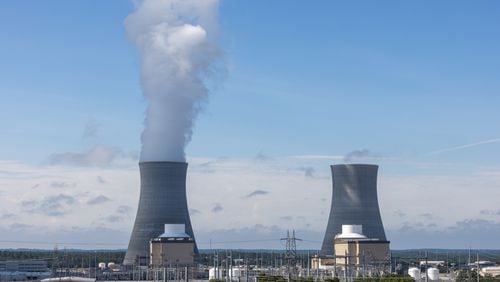The long-delayed second new nuclear reactor at Plant Vogtle near Augusta reached another milestone Friday afternoon when it synced with the electric grid for the first time, Georgia Power said.
Connecting to the grid is a key step on the path to placing the unit, known as Unit 4, into service. The development comes about two weeks after the company began a self-sustaining fission reaction inside Unit 4′s reactor, a stage known as “initial criticality.”
In a release, Georgia Power said operators will continue testing the unit as they raise its power to 100%.
Unit 4 was supposed to begin providing electricity to Georgians by the end of March, but an issue discovered in one of its critical cooling systems during start-up testing triggered a new delay. The company says the problem has been fixed, but Unit 4 is now expected to enter service sometime between April and June.
The new Vogtle units are the first new commercial reactors built from scratch in the U.S. in more than three decades. Unit 3 has been in service since last July and once Unit 4 is complete, the two reactors combined will produce enough electricity to power 1 million homes, without adding heat-trapping carbon pollution to the atmosphere.
But the project’s years of delays and rising costs have been a burden on Georgia Power’s ratepayers.
Unit 3 entered service more than seven years behind schedule, and Unit 4 is likely to reach the finish line more than seven years later than expected, too. The total cost of the expansion has surpassed $35 billion, more than $20 billion over its initial estimated price tag.
Before the first new unit produced any electricity, the average Georgia Power residential customer had already paid about $1,000 over the last decade-plus in monthly bill fees to cover financing costs.
Late last year, state regulators voted to approve a deal that passed $7.56 billion of Vogtle’s construction costs onto the company’s ratepayers. As a result, the average residential customer using 1,000 kilowatt-hours of electricity a month will see a cumulative increase of $14.38 in their monthly bills. A portion of that increase — about $5.42 — kicked in last year after Unit 3 entered service. The rest will take effect when Unit 4 comes online.
Georgia Power holds the largest ownership stake in the Vogtle expansion with 45.7%, followed by Oglethorpe Power (30%), the Municipal Electric Authority of Georgia (22.7%) and Dalton Utilities (1.6%).
As the company prepares to bring Unit 4 online, it is already asking to add more electricity assets to its fleet.
Georgia Power has submitted a plan to the Georgia Public Service Commission (PSC) to add roughly 3,400 megawatts (MW) of new generating capacity to its system to meet a demand crunch it says is coming. The demand is mostly coming from electricity-hungry data centers serving artificial intelligence, cryptocurrency, social media companies and others.
During hearings on the plan this week, witnesses for the PSC’s public interest advocacy staff said they agree demand is growing, but not as fast as Georgia Power projects.
The commission is expected to take a final vote on the company’s proposal on April 16.
A note of disclosure
This coverage is supported by a partnership with Green South Foundation and Journalism Funding Partners. You can learn more and support our climate reporting by donating at ajc.com/donate/climate/
About the Author







